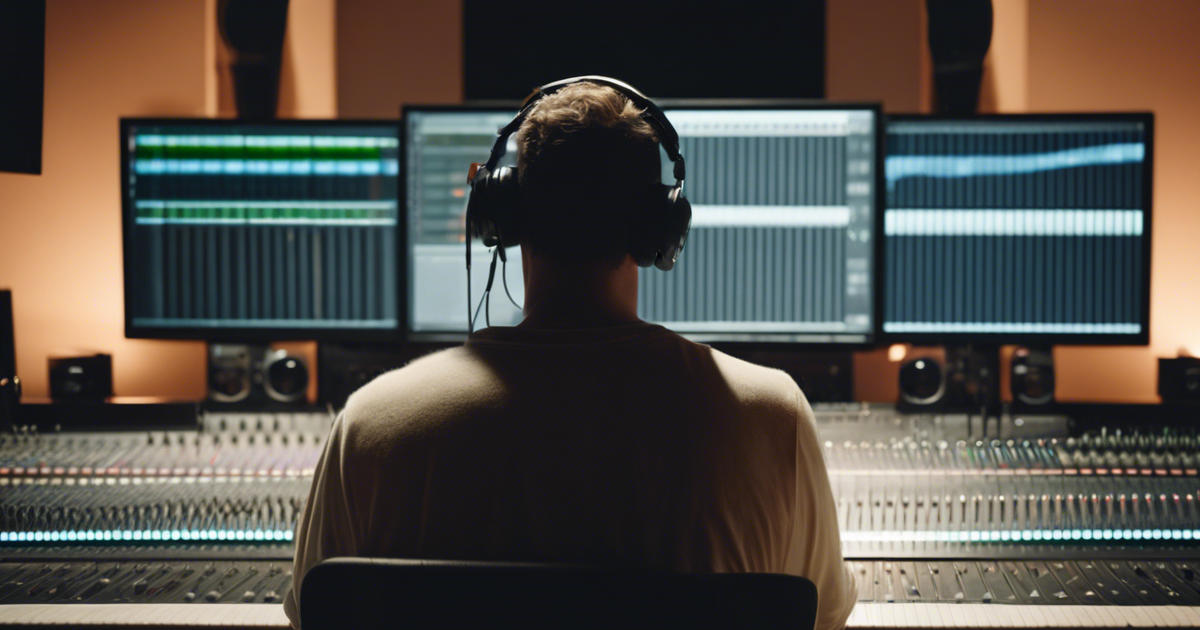Estimated reading time: 9 minutes
Introduction: The Dawn of Digital Audio
In the ever-evolving world of music production, staying up-to-date with technology is crucial. One term that has been a game-changer in the industry is ADAT. But what exactly is ADAT, and why should music producers care about it? Let’s dive into this digital audio format that has revolutionized recording studios and project setups alike.
Table of contents
What is ADAT?
ADAT, which stands for Alesis Digital Audio Tape, is a digital recording format introduced by Alesis, an American music technology manufacturer, in the early 1990s. Initially, ADAT referred to both the tape format and the recording hardware, but over time, it has come to represent a digital audio transfer protocol widely used in professional audio equipment.
The Birth of ADAT
When ADAT was first introduced, it was a major milestone in the world of music production. Before ADAT, multitrack recording often required expensive and bulky tape machines. ADAT brought the power of digital multitrack recording to a more affordable and compact package, allowing for eight tracks of digital audio to be recorded on a single S-VHS tape.
ADAT Lightpipe: Beyond the Tape
While the original ADAT tape format is now obsolete, the ADAT Lightpipe interface that was developed alongside it continues to be widely used. This optical interface allows for the transfer of multiple channels of digital audio between devices using a single cable, which has become a standard in many studio setups.
Key Components of ADAT
To fully understand ADAT, let’s break down some of its key components and features:
Sample Rate and Bit Depth
ADAT supports various sample rates, typically 44.1 kHz or 48 kHz, which determine how many times per second the audio is sampled. The original ADAT format used 16-bit resolution, but modern ADAT-compatible devices often support 24-bit audio, offering higher dynamic range and better audio quality.
Channels of Audio
One of the most significant features of ADAT is its ability to transmit multiple channels of audio simultaneously. A single ADAT connection can carry up to 8 channels of audio at 44.1 or 48 kHz sample rates, or 4 channels at 88.2 or 96 kHz.
Optical Cables
ADAT uses optical cables, often referred to as TOSLINK cables, to transmit digital audio signals. These fiberoptic cables offer several advantages:
- Immunity to electromagnetic interference
- Capability to transmit multiple channels over long distances
- No ground loop issues, which can plague analog connections
Sample Multiplexing
ADAT employs a technique called Sample Multiplexing (S/MUX) to handle higher sample rates. This allows for maintaining the same channel count at higher sample rates by combining multiple ADAT streams.

The ADAT Lightpipe Interface
The ADAT Lightpipe interface has become a standard in the audio industry, extending far beyond its original use with ADAT recorders. Let’s explore why it’s so widely adopted:
Versatility in Studio Setups
ADAT Lightpipe allows for easy expansion of audio interfaces and mixing consoles. For example, an 8-channel audio interface can be expanded to 16 or 24 channels by adding external preamps or converters with ADAT connectivity.
Simplifying Cable Management
Instead of running multiple analog cables between devices, a single ADAT optical cable can carry 8 channels of audio. This not only reduces clutter but also maintains signal integrity over longer distances.
Integration with Modern DAWs
Most modern Digital Audio Workstations (DAWs) support ADAT inputs and outputs, allowing for seamless integration of external hardware with computer-based recording systems.
ADAT in Practice: Applications for Music Producers
Now that we understand what ADAT is let’s look at how music producers can utilize this technology in their workflows:
Expanding Channel Count
For project studio owners looking to record full bands or larger ensembles, ADAT provides an affordable way to increase the number of simultaneous recording channels. By adding an 8-channel mic preamp with ADAT output to an existing interface, you can double your input capacity without breaking the bank.
Integrating Outboard Gear
ADAT allows for easy integration of outboard processors, such as hardware compressors or EQs, into a digital workflow. You can send multiple channels out to analog gear and bring them back into your DAW without the need for additional AD/DA converters.
Distributing Audio in Complex Setups
In larger studio environments, ADAT can be used to distribute audio between different rooms or areas. For example, you could send a multitrack feed from the control room to a live room for custom headphone mixes.
Synchronization and Clock Sources
ADAT connections can also carry word clock information, which is crucial for keeping multiple digital devices in sync. This allows for designating a master clock source and ensuring all connected devices are perfectly aligned, preventing timing issues in recordings.

Considerations When Using ADAT
While ADAT offers many benefits, there are some factors to keep in mind:
Latency
When routing audio through multiple devices using ADAT, be aware of potential latency. While generally minimal, it can add up in complex signal chains and may need to be compensated for in your DAW.
Sample Rate Limitations
At higher sample rates (88.2 kHz and above), the number of channels that can be transmitted over a single ADAT connection is reduced. Plan your routing accordingly if you’re working at these rates.
Compatibility
While ADAT is widely supported, not all devices implement it in the same way. Always check compatibility and specifications when integrating new gear into your setup.
The Future of ADAT
Despite being introduced decades ago, ADAT remains relevant in modern music production. Its continued use is a testament to its utility and the industry’s need for a standardized multi-channel digital audio format.
ADAT and Modern Interfaces
Many contemporary audio interfaces still include ADAT ports, recognizing the format’s ongoing importance in studio setups. This allows for seamless integration with both legacy and cutting-edge equipment.
Alternatives and Complementary Technologies
While ADAT continues to be widely used, other digital formats like Dante and AVB are gaining traction, especially in larger installations. However, these often coexist with ADAT rather than replacing it entirely.
Video: What is ADAT? – Synthax Explains
Conclusion: Embracing ADAT in Your Production Workflow
Understanding ADAT is crucial for any music producer looking to expand their studio capabilities or work in professional environments. Its ability to transmit multiple channels of high-quality audio over a single cable has made it a staple in recording studios of all sizes.
Whether you’re looking to add more inputs to your home studio, integrate outboard gear with your DAW, or simply understand the technology behind professional audio setups, ADAT is a format worth knowing. By embracing ADAT, you open up a world of possibilities for expanding your recording and mixing capabilities without the need for expensive, complex setups.
As you continue to grow as a music producer, keep ADAT in mind as a powerful tool for increasing the flexibility and capacity of your studio. Its enduring presence in the industry ensures that knowledge of ADAT will serve you well in various recording scenarios, from small project studios to large professional facilities.
Remember, the key to great music production isn’t just about having the latest gear—it’s about understanding and effectively using the tools at your disposal. ADAT, with its balance of simplicity and capability, remains one of those essential tools in the modern producer’s arsenal.
Related Posts
FAQs
ADAT stands for Alesis Digital Audio Tape, a digital recording format introduced by Alesis in the early 1990s. It revolutionized music production by providing a more affordable and compact way to achieve digital multitrack recording, initially using S-VHS tapes to record eight tracks of digital audio. Today, ADAT is widely recognized for its digital audio transfer protocol, the ADAT Lightpipe, which facilitates seamless audio transfer between devices, making it a crucial tool in modern recording studios.
While the original ADAT tape format is now obsolete, the ADAT Lightpipe interface continues to be widely used. The ADAT Lightpipe is an optical interface that allows for the transfer of multiple channels of digital audio between devices using a single optical cable. This interface has become a standard in the industry due to its ability to simplify cable management, maintain signal integrity over long distances, and integrate seamlessly with modern Digital Audio Workstations (DAWs).
ADAT technology includes several key components:
Sample Rate and Bit Depth: ADAT supports sample rates of 44.1 kHz or 48 kHz, with modern devices often supporting up to 24-bit audio for higher quality.
Channels of Audio: A single ADAT connection can carry up to 8 channels of audio at standard sample rates or 4 channels at higher rates like 88.2 kHz or 96 kHz.
Optical Cables: Uses fiberoptic TOSLINK cables that offer immunity to electromagnetic interference, the ability to transmit multiple channels over long distances, and no ground loop issues.
Sample Multiplexing (S/MUX): A technique used to maintain channel count at higher sample rates by combining multiple ADAT streams.
ADAT offers several practical applications for music producers:
Expanding Channel Count: Allows for increasing the number of recording channels affordably by adding additional ADAT-compatible devices.
Integrating Outboard Gear: Facilitates the integration of external hardware processors with a digital workflow without needing extra AD/DA converters.
Distributing Audio in Complex Setups: Useful for distributing audio signals across different rooms or areas in larger studios, ensuring synchronized audio distribution.
Synchronization: Carries word clock information to keep multiple digital devices in sync, crucial for preventing timing issues in recordings.
Music producers should keep in mind the following considerations when using ADAT:
Latency: Be aware of potential latency when routing audio through multiple ADAT-connected devices, which may require compensation in your DAW.
Sample Rate Limitations: Higher sample rates reduce the number of channels that can be transmitted over a single ADAT connection, so plan routing accordingly.
Compatibility: Ensure that all devices in your setup are compatible with ADAT and check their specifications to avoid integration issues.
Understanding these factors can help maximize the benefits of ADAT in a studio environment.
